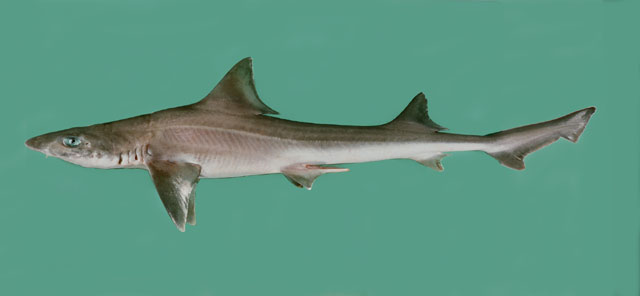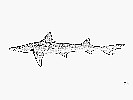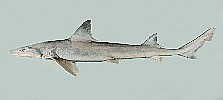Mustelus mosis
Hemprich & Ehrenberg, 1899
Arabian smooth-hound
Classification: Elasmobranchii Carcharhiniformes Triakidae
Reference of the original description
Symbolae physicae, seu, Icones et descriptiones corporum naturalium novorum aut minus cognitorum : quae ex itineribus per Libyam Aegyptum Nubiam Dongalam Syriam Arabiam et Habessiniam publico institutis sumptu Friderici Guilelmi Hemprich et Christiani Godofredi Ehrenberg : studio annis MDCCCXX-MDCCCXXV redierunt. Zoologica. Berolini [Berlin](Reimer): 1–17, 31 plates [10 on fishes]
Symbolae physicae, seu, Icones et descriptiones corporum naturalium novorum aut minus cognitorum : quae ex itineribus per Libyam Aegyptum Nubiam Dongalam Syriam Arabiam et Habessiniam publico institutis sumptu Friderici Guilelmi Hemprich et Christiani Godofredi Ehrenberg : studio annis MDCCCXX-MDCCCXXV redierunt. Zoologica. Berolini [Berlin](Reimer): 1–17, 31 plates [10 on fishes]
Synonyms / new combinations and misspellings
Mustelus cf. mosis
Mustelus cf. mosis
Description :
Citation: Mustelus mosis Hemprich & Ehrenberg, 1899: In: Database of modern sharks, rays and chimaeras, www.shark-references.com, World Wide Web electronic publication, Version 12/2025
Please send your images of "Mustelus mosis" to info@shark-references.com

Mustelus mosis Hemprich & Ehrenberg, 1899, © Randall, J.E, www.fish-base.org

Mustelus mosis Hemprich & Ehrenberg, 1899, © Randall, J.E, www.fish-base.org
Common names
 Musola arábiga,
Musola arábiga,  Emissole d"Arabie,
Emissole d"Arabie,  Arabian smooth hound,
Arabian smooth hound,  Arabian smooth-hound,
Arabian smooth-hound,  Gummy smooth hound,
Gummy smooth hound,  Hardnose smooth hound,
Hardnose smooth hound,  Hardnosed smooth-hound,
Hardnosed smooth-hound,  Moses smooth hound,
Moses smooth hound,  Moses smooth-hound
Moses smooth-hound
 Musola arábiga,
Musola arábiga,  Emissole d"Arabie,
Emissole d"Arabie,  Arabian smooth hound,
Arabian smooth hound,  Arabian smooth-hound,
Arabian smooth-hound,  Gummy smooth hound,
Gummy smooth hound,  Hardnose smooth hound,
Hardnose smooth hound,  Hardnosed smooth-hound,
Hardnosed smooth-hound,  Moses smooth hound,
Moses smooth hound,  Moses smooth-hound
Moses smooth-hound
Short Description
Diagnosis after Compagno, 1984 [517]: Body fairly slender. Head short, prepectoral length 17 to 22% of total length; snout moderately long and bluntly angular in lateral view, tip rather expanded and bulbous in adults with hypercalcified rostral mass, preoral snout 5.5 to 6.6% of total length, preorbital snout 6.3 to 7.3% of total length; internarial space broad, 2.4 to 2.9% of total length; eyes fairly large, eye length 2.1 to 3 times in preorbital snout and 2.5 to 3.3% of total length; interorbital space 2.4 to 2.9% of total length; mouth moderately long, greater than eye length, its length 2.7 to 3.8% of total length; upper labial furrows about equal to lowers and 1.3 to 2% of total length; teeth molariform and asymmetric, with cusp reduced to a low point, cusplets absent except in very young sharks; buccopharyngeal denticles covering anterior half of palate and mouth floor or entire palate and floor. Interdorsal space 20 to 23% of total length; trailing edges of dorsal fins denticulate, without bare ceratotrichia; first dorsal somewhat falcate, with posterior margin nearly vertical from apex, its midbase closer to pectoral bases than to pelvics; pectoral fins moderate-sized, length of anterior margin 13 to 15% of total length, width of posterior margin 9.8 to 13% of total length; pelvic fins small, anterior margin length 6.5 to 7.9% of total length; anal height 2.9 to 4.7% of total length; anal caudal space greater or subequal to second dorsal height, and 7.1 to 9.1% of total length; ventral caudal lobe more or less falcate in adults. Crowns of lateral trunk denticles lanceolate or tricuspidate, with longitudinal ridges extending their entire length. Rostral node of cranium, hyomandibulae, scapulocoracoid tips; sometimes supraorbital crests and rostral shafts of cranium, extrabranchial cartilages, and radials of second dorsal, pectoral, pelvic, and caudal fin radials hypercalcified in adults; palatoquadrates not subdivided; monospondylous precaudal centra 25 to 39, diplospondylous precaudal centra 34 to 48, precaudal centra 59 to 81. Colour uniform grey or grey-brown, above, light below, no white or dark spots or dark bars; South African examples generally have white-tipped first dorsal and black-tipped second dorsal and caudal. Development viviparous. Size large, adults 63 to 150 cm.
Diagnosis after Compagno, 1984 [517]: Body fairly slender. Head short, prepectoral length 17 to 22% of total length; snout moderately long and bluntly angular in lateral view, tip rather expanded and bulbous in adults with hypercalcified rostral mass, preoral snout 5.5 to 6.6% of total length, preorbital snout 6.3 to 7.3% of total length; internarial space broad, 2.4 to 2.9% of total length; eyes fairly large, eye length 2.1 to 3 times in preorbital snout and 2.5 to 3.3% of total length; interorbital space 2.4 to 2.9% of total length; mouth moderately long, greater than eye length, its length 2.7 to 3.8% of total length; upper labial furrows about equal to lowers and 1.3 to 2% of total length; teeth molariform and asymmetric, with cusp reduced to a low point, cusplets absent except in very young sharks; buccopharyngeal denticles covering anterior half of palate and mouth floor or entire palate and floor. Interdorsal space 20 to 23% of total length; trailing edges of dorsal fins denticulate, without bare ceratotrichia; first dorsal somewhat falcate, with posterior margin nearly vertical from apex, its midbase closer to pectoral bases than to pelvics; pectoral fins moderate-sized, length of anterior margin 13 to 15% of total length, width of posterior margin 9.8 to 13% of total length; pelvic fins small, anterior margin length 6.5 to 7.9% of total length; anal height 2.9 to 4.7% of total length; anal caudal space greater or subequal to second dorsal height, and 7.1 to 9.1% of total length; ventral caudal lobe more or less falcate in adults. Crowns of lateral trunk denticles lanceolate or tricuspidate, with longitudinal ridges extending their entire length. Rostral node of cranium, hyomandibulae, scapulocoracoid tips; sometimes supraorbital crests and rostral shafts of cranium, extrabranchial cartilages, and radials of second dorsal, pectoral, pelvic, and caudal fin radials hypercalcified in adults; palatoquadrates not subdivided; monospondylous precaudal centra 25 to 39, diplospondylous precaudal centra 34 to 48, precaudal centra 59 to 81. Colour uniform grey or grey-brown, above, light below, no white or dark spots or dark bars; South African examples generally have white-tipped first dorsal and black-tipped second dorsal and caudal. Development viviparous. Size large, adults 63 to 150 cm.
Distribution
Western Indian Ocean: Red Sea and East Africa [20041] to Maldives, India and Sri Lanka. Source: www.gbif.org
Western Indian Ocean: Red Sea and East Africa [20041] to Maldives, India and Sri Lanka. Source: www.gbif.org
Human uses
fisheries: commercial; gamefish: yes
fisheries: commercial; gamefish: yes
Biology
Viviparous, with 6 to 10 young in a litter; born at 26-28 cm [20040]. Distinct pairing with embrace [17086]. Occurs in continental waters, both inshore and offshore. Sometimes seen on coral reefs. Feeds on small bottom fishes, mollusks, and crustaceans [517] [20042].
Viviparous, with 6 to 10 young in a litter; born at 26-28 cm [20040]. Distinct pairing with embrace [17086]. Occurs in continental waters, both inshore and offshore. Sometimes seen on coral reefs. Feeds on small bottom fishes, mollusks, and crustaceans [517] [20042].
Remarks
shark-references Species-ID=3810;
shark-references Species-ID=3810;
Parasites (arranged by Jürgen Pollerspöck)
Cestoda
Copepoda
Cestoda
- Calliobothrium narsisae Saghavaz & Haseli, 2024 [33063]
- Callitetrarhynchus gracilis (Rudolphi, 1819) Pintner, 1931 [24101]
- Coronocestus diamanti (Ivanov & Lipshitz, 2006) [7573]
- Coronocestus hormozganiense (Haseli, Malek, Palm & Ivanov, 2012) [16471] [19536]
- Orygmatobothrium persiense Moghadam & Haseli, 2019 [27127]
Copepoda
- Achtheinus dentatus Wilson, 1911 [27172]
- Perissopus dentatus Steenstrup & Lütken, 1861 [15305]
- Pseudopandarus gracilis Kirtisinghe, 1950 [15305] [25052] [27172]
- Pseudopandarus longus (Gnanamuthu, 1951) [15305] [25052] [27172]


















